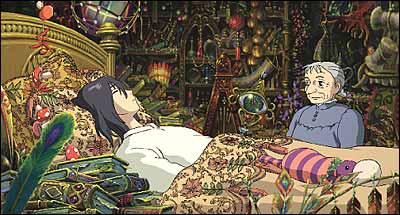
The great animation director Hayao Miyazaki frequently gives us a gift too often withheld from contemporary cartoons: blessed quiet. Watching the opening moments of his latest wonder-work, Howl’s Moving Castle—seeing the way the contraption of the title, a gigantic, bulbous wood-and-metal edifice that lumbers along a pastel countryside dotted with silent sheep—you’re struck by the exceedingly odd beauty of the scene. You also may find yourself thankful that you’re not trapped in another noisy, frenetic joke-machine of a cartoon like Madagascar or Shrek 2, where the ceaseless rat-a-tat-tat of topical gags and body-odor yuks serve primarily to introduce kiddies to the very definition of “flop sweat.” Although those last two movies may make far more money than the serenely nuanced Howl’s Moving Castle, they are films that beg for an audience’s love, and you can be pretty sure that children recognize such unseemly flailing, even as they may snort and snicker enthusiastically.
By contrast, there is giggling, belly-laughing, and gasping to be done watching Howl’s Moving Castle. The Japanese director has adapted the popular British writer Diana Wynne Jones’s 2000 novel, about a teenage nineteenth-century hat-maker named Sophie (voiced by Emily Mortimer) who falls in love with a dashing and brave but vain young man (Christian Bale). Another gorgeous quiet moment occurs early on. As creepy, ink-black blobs chase Sophie and her new friend, he suddenly lifts her with him into the sky and tells her to do what he’s doing: to move her legs and walk on the air—it’s breathtaking. Alas, Sophie’s pursuit of love is impeded when she has a spell cast upon her that turns her into a hunched 90-year-old woman (voice supplied, in a wonderful return to the screen, by Jean Simmons), whom the young man—who proves to be the Prince Howl of the title—fails to recognize. And he has his own transformational problems: His body starts turning, part by part, into a bird. Rarely have metaphors for sprouting adolescence and adulthood been more elegantly portrayed.
Wynne Jones’s tale—in contrast to the piquant simplicity of Miyazaki’s screenplays for previous great films such as Spirited Away and Kiki’s Delivery Service—is rather knotty. The meanie who casts Sophie’s spell is an immense harridan called the Witch of the Waste (voiced by Lauren Bacall!); she makes a long journey that parallels Sophie’s trip to the kingdom where the prince’s parents, as king and queen, are preoccupied with an impending war. (Lovely but deadly zeppelins float next to clouds.) And the heaving hulk that lurches around the countryside is inhabited by a yackety little ball of fire named Calcifer, who seems to provide the power for the moving castle. Calcifer is voiced by Billy Crystal, reprising his manic-voice shtick from The Princess Bride—the first instance in a Miyazaki film of a grating, mood-disrupting miscalculation.
There are times when the intricate complexity of Wynne Jones’s British-fantasy tradition clashes with Miyazaki’s career-long impulse to follow the unpredictable whims of dream logic wherever they may take him. Immensely popular in his homeland (Howl’s is proportionately a bigger hit in Japan than Madagascar is here, for example), the director is an independent filmmaker unbound by American animation’s often corporate traditions and formulaic storytelling (the wisecracking animal sidekicks; the tidy, instructive happy endings). In the best moments of Howl’s Moving Castle and in his extraordinary body of work, Miyazaki teaches his viewers more valuable lessons: that cultivating a kind of meditative dreaminess is important, that logic is fallible and often benefits from surrendering to instinct, that hushed visual beauty is a treasure unto itself.
Howl’s Moving Castle
Directed by
Hayao Miyazaki.
Walt Disney Pictures. PG.